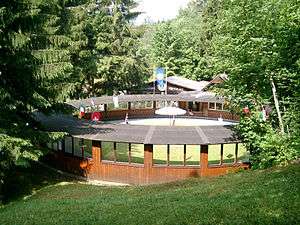Tether car

Tether Cars are model racing cars powered by miniature internal combustion engines and tethered to a central post. Unlike radio control cars, the driver has no remote control over the model's speed or steering.
Basics
The little cars are powered by a non-radio controlled model aeroplane engine, ( two stroke, glow plug, piston liner, etc. ) and run on fuel supplied by a fuel tank within the car. Over the past couple of years, electric motor driven cars, powered by batteries, have also emerged.[1]
History
Tether cars were developed beginning in the 1920s–1930s and still are built, raced and collected today. First made by hobby craftsmen, tether cars were later produced in small numbers by commercial manufacturers such as Dooling Brothers (California), Dick McCoy (Duro-Matic Products), Garold Frymire (Fryco Engineering) BB Korn, and many others. Original examples of the early cars, made from 1930s to the 1960s, are avidly collected today and command prices in the thousands of dollars.
Today
There are tracks in Australia (Brisbane and Sydney), New Zealand, Switzerland, Estonia, Ukraine, Russia, America and more. World Championships are held every 3 years, the 2013 World Championships was held in Basel, Switzerland. Today, tether cars are run throughout the world.
World Records
See also
- Cox Models A former manufacturer of ready to run tether cars
- Control line flying model
References
- ↑ Vector Racing (Electric powered tether cars)
External links
- Vintage Miniature Gas Powered Race Cars, private website covering the early history of tether cars
- Speedmodelcar.com, most updated website with international results and information
- AMRCA - American Miniature Racing Car Association
- WMCR - World Organisation for Model Car Racing
- Vintage Miniature Gas Powered Race Cars, private website covering the early history of tether cars
- GMBK - Gävle ModellBil Klubb